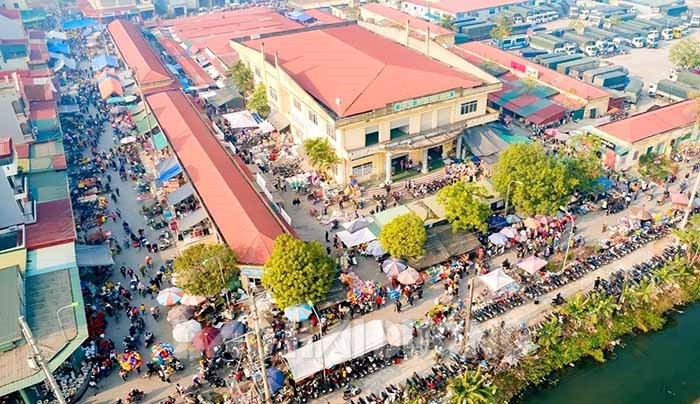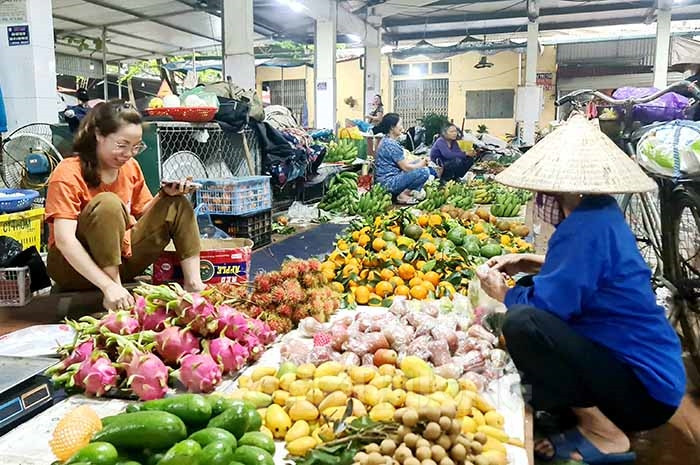In recent years, the infrastructure of many markets has been invested in, renovated, and made spacious and clean, which has been effective, contributing to promoting trade, product consumption, and improving people's lives and incomes.

The infrastructure of rural markets according to the new criteria is spacious, clean and beautiful, contributing to promoting local socio-economic development. In the photo: Do Market in Ung Hoe commune, Ninh Giang (photo provided by the facility)
The old, shabby, and shabby rural markets have now been replaced by spacious, clean areas according to new standards.
Spacious, clean and beautiful
Cam Hoang Market (Cam Giang) is located in the central area of this commune. The market is 2,500 m2 wide, divided into separate areas, the stalls are neatly arranged with full ancillary facilities. This is a bustling trading and business place not only for the people of Cam Hoang commune but also for neighboring localities.
Ms. Dinh Thi Loi, a clothing trader at Cam Hoang commune market, shared: “Before the market was built, I did business at home, but because my house was not in the center, there were few shoppers. Since the market was built, I have moved my shop to the market to do business. The market serves the shopping needs of people in many communes, so the consumption is very stable. The market has everything from televisions to security cameras, so traders are very secure in doing business at the market.”
According to Mr. Hong Quang Thuan, Chairman of the Veterans Association and Head of the Cam Hoang Commune Market Management Board, this is one of the oldest markets in the locality, built a long time ago and has deteriorated. The market has only 3 rows of small, narrow kiosks, so it is not enough to serve the needs of traders and people. Most of the traders do business on the edge of the road, encroaching on the traffic safety corridor and posing many potential risks. In 2018, after completing the investment in upgrading and expanding the market, the commune established a Management Board and assigned the Veterans Association to be in charge. Since then, Cam Hoang market has been operating stably to serve the needs of people in the area.

Cam Hoang market has been upgraded and expanded, creating favorable conditions for local people to trade and increase income.
Previously, An Binh commune (Nam Sach) did not have a market, so people's buying and selling was very difficult. To serve the needs of local people, when building a new rural area, the commune proposed to build a market in An Dong village and was approved by the district. In 2016, the market was built, in 2019 it was renovated and expanded with an area of over 3,100 m2 with more than 80 kiosks along with electricity, water, toilets, fire prevention and fighting equipment, etc.
Mr. Truong Phuc Thuc, Vice Chairman of An Binh Commune People's Committee, Head of the Market Management Board said: "Previously, people encroached on the road and sidewalks to make a market place, which not only ruined the beauty but also caused traffic safety problems. Since the new market was built, people have had a stable place to trade and have spacious seats. Business and trade have developed, so the lives of many households in the commune have also improved."
Before implementing the National Target Program on New Rural Development, the rural trade infrastructure in the province was not well developed, and people's exchange of goods was mainly carried out through traditional markets. The infrastructure of many markets was degraded, often flooded during the rainy season, and did not ensure fire prevention and fighting. With the determination of all levels and sectors, in recent years, the rural trade infrastructure in the area has developed strongly. After being invested in construction and renovation, some markets have been effective, contributing to helping local people expand trade, promote product consumption, and better serve the lives of local people.
Synchronous and effective management
According to the Trade Management Department (Department of Industry and Trade), in the period of 2014-2020, the Department of Industry and Trade coordinated with the Department of Planning and Investment to appraise the dossiers and submit to the Provincial People's Committee for decision to support investment in renovating and upgrading infrastructure for 39 markets in 11/12 district-level units in the province with a total support amount of more than 19.4 billion VND. Currently, many localities have policies to attract units and individuals to invest in building markets. Thanks to that, the rural market network has completely changed compared to the previous period. According to the Master Plan for Trade Development of Hai Duong Province to 2025, with a vision to 2030, the whole province has 172 markets in 265 communes, wards and towns (3 grade 1 markets, 20 grade 2 markets, 149 grade 3 markets). Of which, there are 128 rural markets in 226 communes. After merging administrative boundaries, the whole province still has 121 rural markets in 178 communes.
Currently, most rural markets in the province are solid and semi-solid, the market floor is hardened, and the drainage system meets standards. Market stalls are also repaired and replaced with corrugated iron roofs. Fire prevention, environmental protection, and food safety and hygiene are increasingly concerned and focused on. This has attracted a large number of traders and people to participate in trading at the market, contributing to helping local people expand trade in goods, promote product consumption, and better serve the lives of local people.
It can be affirmed that the rural market network has contributed positively to the consumption of products, improving the lives and incomes of rural people. However, the development and completion of rural trade infrastructure in many localities still faces difficulties. The reason is that the funding source to implement the criteria for rural trade infrastructure is limited. Some places have private investment, so many items do not meet standards, lack fire prevention and fighting systems, etc.
To effectively develop and exploit the rural market system, local authorities need to have solutions to effectively manage market activities in the area, avoid waste; clear out all temporary markets, "toad" markets that cause disorder, traffic safety, and environmental pollution. In addition, it is necessary to train management staff, transform market management models for effective business, contributing to promoting local socio-economic development...
Trang Hien